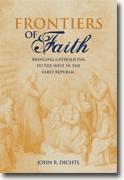Frontiers of Faith
John R. Dichtl
book reviews:
· general fiction
· chick lit/romance
· sci-fi/fantasy
· graphic novels
· nonfiction
· audio books
· author interviews
· children's books @
curledupkids.com
· DVD reviews @
curledupdvd.com
newsletter
win books
buy online
links
home
for authors
& publishers
for reviewers

 |
Frontiers of Faith: Bringing Catholicism to the West in the Early Republic John R. Dichtl University of Kentucky Press Hardcover 240 pages May 2008 |
|
John R. Dichtl’s Frontiers of Faith
Charles Carroll, a cousin of John Carroll, was the only Catholic to sign the Declaration of Independence. Very few Catholics resided in the U.S. in its early days, and most were in Maryland. The Pope made John Carroll America’s first bishop and designated Baltimore, Maryland, to be the first see (or seat) of this very large diocese. Carroll relied heavily on missionary priests from Europe to help him and the growing clergy in America make sure that they had power and authority over the laypeople. The laypeople were open to this in the early days of the Catholic Church in America, since most of the clergy would reside in one place for some time but would travel around the region searching for other Catholics and providing them with the Sacraments and other aid. The Catholic clergy feared that Catholics could lose their faith being surrounded by Protestants who were quicker and more able to set up churches and provide ministers. Anti-Catholicism was not yet as rampant as it would later become as more Catholic immigrants entered the country. Catholic clergy tried to convert non-Catholics, or at least impress them to have a positive attitude toward Catholics. The clergy achieved this by preaching sermons expounding Catholicism as the true Faith and by impressing non-Catholics with Church-related processions, ceremonies, art and architecture. Some non-Catholics were persuaded to either convert or to help with financial needs of the Church, such as helping to build a cathedral or a school. Because the Catholic clergy were sent out to places far from the control or oversight of the bishop and other superiors, some grew too independent and became rogue priests who formed their own “churches”. They opposed the bishop and even took him to court. Fearing that this would cause scandal for the non-Catholics, Bishop Carroll and the other superiors chose not to publicly ride roughshod on the rogue clergy but took as quiet a way as possible to discipline their clergy when needed. They also took their time sorting out problematic situations; when the bishop was taken to court by these rogue priests, he usually won the case. Dichtl researched this book using sources from clerical points of view - the lay point of view is present but not emphasized as fully as that of the clergy. The structure of this history is based on the Catholic Church’s own hierarchical structure and includes endnotes, a bibliography of works cited, and an index. The lack of illustrations or maps detracts from the book; maps might have helped the reader place where the author was talking about. The dust jacket features an image of a Fr. Fenwick giving a blessing in Ohio. This is a well-written presentation of the history of the Catholic Church as it expanded into the American West and is a highly recommended addition to other volumes of American Catholic Church history, particularly to those interested in this period of American Catholic history. John R. Dichtl is the executive director of the National Council on Public History. Originally published on Curled Up With A Good Book at www.curledup.com. © Br. Benet Exton, O.S.B., 2009 |
|
|
|
 Click here to learn more about this month's sponsor! |
|
| fiction · sf/f · comic books · nonfiction · audio newsletter · free book contest · buy books online review index · links · · authors & publishers reviewers |
|
| site by ELBO Computing Resources, Inc. | |
 Around 1785, after the end of the American Revolution, Catholics in the United States were beginning to set up the formally structured Catholic Church with a hierarchy. Fr. John Carroll became the head of the Catholic Church in the U.S., which put him in charge of a large area encompassing the new 13 states and the territory to their west. He did not have many priests or religious to help him with this daunting task.
Around 1785, after the end of the American Revolution, Catholics in the United States were beginning to set up the formally structured Catholic Church with a hierarchy. Fr. John Carroll became the head of the Catholic Church in the U.S., which put him in charge of a large area encompassing the new 13 states and the territory to their west. He did not have many priests or religious to help him with this daunting task.